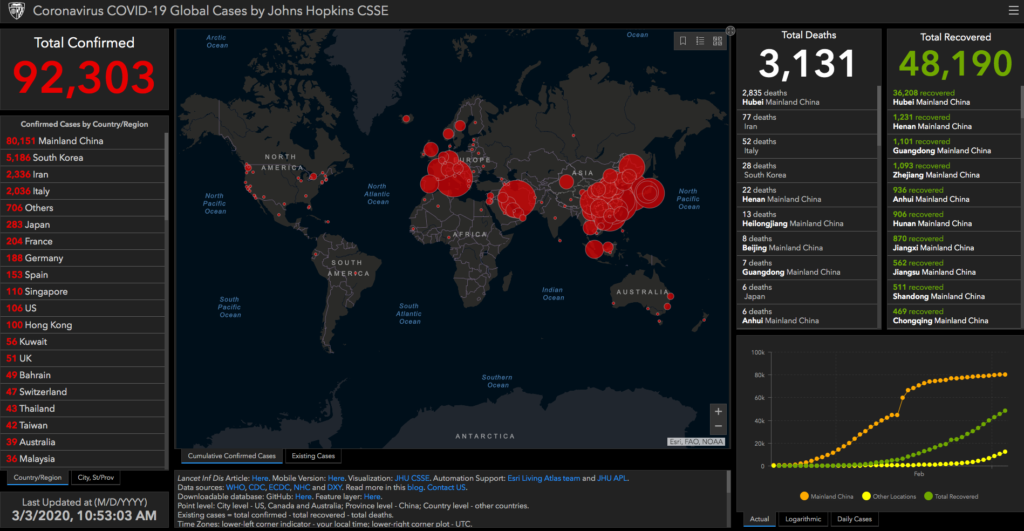How is higher education responding to the COVID-19 coronavirus outbreak?
(If you’re new to this blog, I’ve been tracking the virus since it appeared in January, as part of my broader project of studying the future of higher education. You can find all of my posts about the topic here.)
The virus continues to spread. I won’t summarize that here today, because of time, but you can find more from these sources. It’s starting to impact some campuses now. The University of Sydney lost more than one fifth of its students, who are Chinese nationals. Several California and Washington state universities stated that some of their populations have been exposed to the coronavirus. A researcher (not faculty?) at Rice University (Texas) might have COVID-19, so the campus “asked a ‘small group of students and faculty’ to self-quarantine.” The University of Queensland investigated an infected student who may have visited one of its campuses. New Zealand campuses fear students falling behind in their studies, as well as institutional financial stress. Some universities in northern Italy remain closed. (Japan closed K-12 schools; no impact on higher ed yet.)
Several American campuses announced a suspension of their study abroad and international partnership programs in certain nations: China, Italy, Japan in particular. The United States Centers for Disease Control (CDC) asked all campuses to think about suspending study abroad everywhere:
Given the global outbreak of novel coronavirus (COVID-19) institutes of higher education (IHE) should consider postponing or canceling upcoming student foreign exchange programs. IHE should consider asking current program participants to return to their home country. Those overseeing student foreign exchange programs should be aware that students may face unpredictable circumstances, travel restrictions, challenges in returning home or accessing health care while abroad.
IHEs should consider asking students participating in study abroad programs to return to the United States. (repeated boldface in original)
The US Department of Education announced a task force to look into the impact of this disease on schooling.
Academic events are starting to be hit. EDUCAUSE canceled its ELI conference in Washington state. The Asia-Pacific Association for International Education Conference and Exhibition (#APAIE2020) canceled its Vancouver event. The American Physical Society canceled its Colorado meeting.
Due to rapidly escalating health concerns relating to the spread of the coronavirus disease (COVID-19), the 2020 APS March Meeting in Denver, CO, has been canceled. Please do not travel to Denver to attend the March Meeting. More information will follow shortly. #apsmarch
— American Physical Society (@APSphysics) March 1, 2020
March Madness basketball games might be played without in-person audiences. No word on canceling games and practices; any news on this score, readers?
A University of Albany student party elicited attention and controversy for having a coronavirus theme:
A since-deleted video of off-campus party, which featured Corona Extra beer, surgical masks and a white sheet decorated with a biohazard symbol, appeared on the Instagram account @BarstoolAlbany last weekend with the caption, “Corona virus isn’t gonna stop anyone from partying.”
Academic research continues worldwide, even dramatically:
https://twitter.com/Dali_Yang/status/1234861499019153421
What does this all mean?
Campuses may be reacting more quickly than they did a month ago. Karin Fischer notes of the decisions to break off connections with afflicted nations: “The swiftness of those decisions is notable in comparison to deliberations when coronavirus first broke out in China.”
Campus emergency plans and exercises seem to be being updated and tested.
How many members of a given academic community lack sufficient access to health care? Think of faculty, staff, and especially students in the developing world, or in the United States. Should they consider themselves infected, some will not seek testing or medical attention. They may suffer and spread COVID-19 further. In addition, how many people employed by colleges and universities lack sufficient sick leave, and will force themselves to keep working while ill? How will institutions address this?
I wonder if campuses or on-campus projects are planning on asking governments for financial relief as international students drop (short term) and public revenues tighten (medium term). Reuters reports that the Italian government is already working up aid plans to its injured economy.
I would like to draw attention to two big, overlapping, and potential developments: a big push online for colleges and universities and a boost to video. Several American universities rapidly migrated classes online for their Chinese partner campuses, including NYU, Duke, and Fort Hays State. That’s both asynchronous (LMS etc) and synchronous (videoconferencing).
This could simply keep going. Students, faculty, and staff may feel increasingly nervous about being in face to face meetings and will prefer to work and study remotely. We already have access to a lot of the tech, and maintain some of it in house: campus hosted or leased LMS, document hosting (Google Apps, Office 365), email, some video solution (Elluminate, Connect, Shindig, Zoom, etc). Networked hardware is fairly widespread, if unevenly.

Me this morning after voting, back in my office. I may be spending a lot more time here.
Which brings us to challenges. My readers know that the digital divide means unequal access to bandwidth, which can limit use of video and large files. Faculty are not universally schooled, practiced in, and happy about teaching online. Campuses may lack sufficient staff to enable a big, fast online push. This is also happening during the middle of academic terms in many instance, which makes the transition even more difficult.
Video may pose particular challenges. While humanity loves video, most are not skilled and practiced at creating it. Think of awful webinars you’ve been exposed to, for a sample of how low the quality can be. And we still don’t view video as an adequate substitute for in person connection, generally; we may deem rushed online education to be a poor experience.
Student age may play a role here. Let’s assume that the data we have now about age and coronavirus lethality holds true, at least in general perception. The older one is, the more dangerous COVID-19 is, especially after age 70. For example, according to the data aggregated by Worldometer:
If this data bears out – or, more importantly, if most people believe and act upon it – then we could see efforts to enroll senior citizens become more digital. Which can be challenging, given that population’s tendency to be less digitally experienced as well as being likely to have less tech access. What are the best practices here if “[w]e will interact with students in a different way,” as an al-Jazeera video quietly observes?
“We will interact with students in a different way.”
Fears of #coronavirus have prompted schools and universities to switch to online teaching. Read the latest: https://t.co/etiLEX9P8C pic.twitter.com/H8C806SWmH
— Al Jazeera English (@AJEnglish) March 3, 2020
There’s a broader context for this discussion. Such an online migration is buttressed by a similar, larger move across society. As people increasingly find face-to-face contact problematic, they will likely shift more functions and experienced into the digital realm. Shopping in stores, where COVID-infected folks will be coughing? Head to Amazon and Etsy. Health care, where crucial workers are overexposed? Anticipate a rise in various forms of telemedicine. Want to see a movie or live concert? The digital world offers plentiful riches. 2020 may well see the past generation’s digital migration accelerate, both in the world at large and within academia in particular.
I will blog more about this potential/unfolding migration as I can.
(thanks to Jay Sieling for one fine link; thanks to my Patreon supporters for thinking through this with me)







I am recommending that my colleagues at George Mason follow your posts w/re to COVID-19 and higher ed. Thank you for providing your usual best quality syntheses and consolidation of critical information for us.
Thank you so much, Michael. I’d love to hear their thoughts.
One thought emerged when I noticed the rushed migration of F2F courses to an online solution. There was reflexive impulse to get lecture capture done and uploaded online in some way. I understand that this would be the most proximal solution for the moment, but I couldn’t help shaking my head a bit at the sense that the solution for continuing F2F instruction is to mimic F2F instruction in a new technology – not to default to the best practice we have already developed for the past 15+ years producing fully online education as a discipline of instructional design.
This is a pattern of human behavior that we have seen in the past: putting the old content into the new medium, e.g., pointing a motion picture film camera at a vaudeville stage, putting movies on TV, putting brochure content on the Internet, and … placing lectures in online courses.
I hope that the outcome of this digression will bring to the forefront that online education is unique and distinct from its F2F cousin. It requires expertise for it to be configured to work, designed to be coherent, supported with faculty mentorship, and meaningful to students.
Ultimately, I hope that those who embody the expertise in these areas will enjoy the benefits of their value to HE institutions where the college’s sustainability is at stake.
Exactly. We love to copy and paste the old habits onto the new tech, first, before we learn.
Great point about lecture capture.
Hi, do you recommend particular resources for online-specific pedagogy?
Claire: Since online education is so wide ranging in its context and audience, I wouldn’t call out one particular resource or set of resources. But the first place I’d go is https://distance-educator.com/ I subscribe to the email feed that aggregates recent research.
Here are Educause’s Community Groups: https://www.educause.edu/community The Instructional Technology group just had a great thread on the best books on Ed Tech: http://listserv.educause.edu/scripts/wa.exe?A1=ind2002&L=INSTTECH#40
Sports-wise: Parts of Italy have been postponing their scheduled soccer matches for a few weeks now. It’s expected that they will eventually have to play in empty stadiums, as the money from their TV contracts is the main source of income for most pro leagues, much more than they get from ticket sales.
Locally, Ann Arbor’s pro soccer team doesn’t start play for over two months, so it will be a while before they announce anything, one way or the other. As for our futsal team, they have two home matches scheduled for March, but given their average attendance is between 100 and 200, I don’t know that anyone will be scared off at the prospect of showing up. (Honestly, the average night club probably has more people, and in closer quarters.)
And the big question still looming is whether the Olympics, scheduled for July in Tokyo, will be canceled. Lots of TV money at play there, but also lots of international travel from all over the world. I’m honestly not sure how that will play out.
Here’s another angle in terms of how COVID-19 might impact colleges longer term. My daughter is a current high school junior in New Hampshire. She is interested in some colleges on the west coast of the US. We have been talking about a trip to California to visit some of them during her break in April. Do we go (our choice)? Can we go (campuses closed or travel restricted)? That’s just one example, but what if lots of potential students and parents postpone or cancel their college search visits? May we see a decline in the coming classes or at least some locality effects like lower enrollments in schools in regions where there are active cases? Schools don’t get a second shot at selling themselves to students.
Pingback: COVID-MOOCs: How Schools Are Using Technology To Learn on Lockdown | LMSPulse